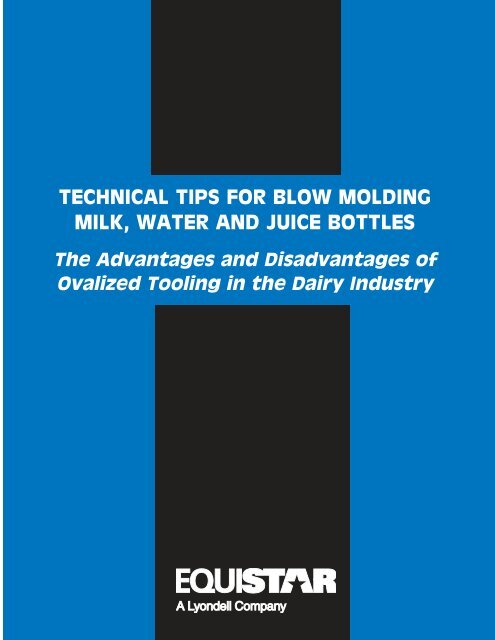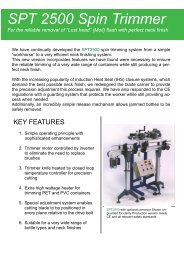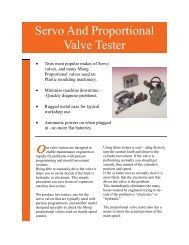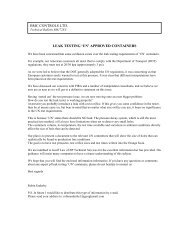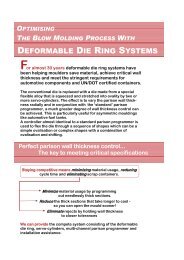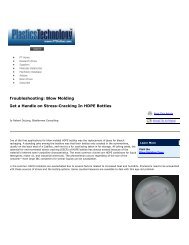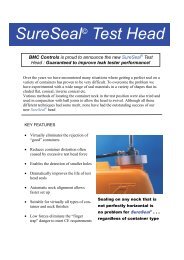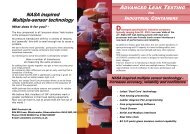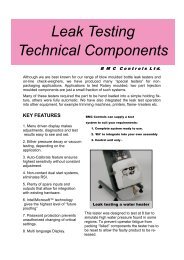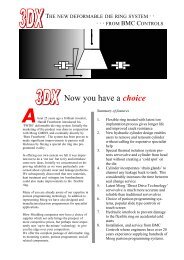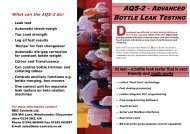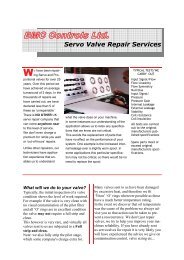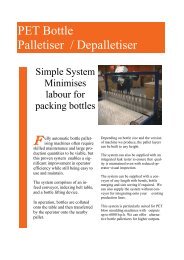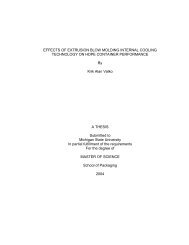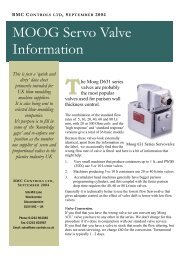Ovalised Tooling for Dairy Bottles - Blow Moulding Controls
Ovalised Tooling for Dairy Bottles - Blow Moulding Controls
Ovalised Tooling for Dairy Bottles - Blow Moulding Controls
You also want an ePaper? Increase the reach of your titles
YUMPU automatically turns print PDFs into web optimized ePapers that Google loves.
TECHNICAL TIPS FOR BLOW MOLDING<br />
MILK, WATER AND JUICE BOTTLES<br />
The Advantages and Disadvantages of<br />
Ovalized <strong>Tooling</strong> in the <strong>Dairy</strong> Industry
TECHNICAL TIPS FOR BLOW MOLDING<br />
MILK, WATER AND JUICE BOTTLES<br />
The Advantages and Disadvantages<br />
of Ovalized <strong>Tooling</strong> in the <strong>Dairy</strong> Industry<br />
ABSTRACT<br />
Ovalized tooling can improve blown bottle quality and possibly reduce resin<br />
usage. However, it is important to realize that any innovation has limitations, and<br />
what may be good <strong>for</strong> one dairy may not be good <strong>for</strong> another. It is also important<br />
to know that using ovalized tooling requires precision alignment in the tools. Thus,<br />
the blow molding machine operator must be vigilant and constantly observant:<br />
Are the parisons dropping straight? Are the ovalized areas on the parisons in the<br />
proper positions? The operator has to monitor the process even more closely than<br />
with round tooling to make sure that acceptable containers are produced. All of<br />
these issues and others must be considered in making the decision to convert to<br />
ovalized tooling; obviously, the equation is more complicated than the cost of the<br />
tooling versus the payback in decreased resin use.<br />
PART 1:<br />
THE ECONOMY OF OVALIZED<br />
HEAD TOOLING<br />
The one-gallon polyethylene milk bottle has been significantly improved since<br />
its inception more than 20 years ago. Since that time, advances in bottle design,<br />
molding equipment, handling equipment and the polymers used to make the<br />
bottles themselves have enabled bottle weights to be reduced substantially, <strong>for</strong><br />
example. When first introduced, the polyethylene milk bottle weighed about<br />
100 grams. Today’s typical milk bottle weighs between 60 and 65 grams. This<br />
weight reduction results in sizeable resin savings <strong>for</strong> the packager and gives the<br />
polyethylene bottle a competitive advantage in the marketplace.<br />
Dramatic reductions in package weight are not likely to continue. However,<br />
even very small additional weight reductions can mean significant savings today<br />
because of the tremendous number of bottles currently produced. One technique<br />
<strong>for</strong> achieving additional weight reduction while maintaining the per<strong>for</strong>mance<br />
standards of the bottle is by using ovalized head tooling. <strong>Bottles</strong> produced with<br />
ovalized tooling have a more uni<strong>for</strong>m wall thickness than those produced with<br />
standard round tooling. Ovalized tooling has been available <strong>for</strong> many years, but to<br />
date has not been widely used in the dairy industry.<br />
This article reviews the per<strong>for</strong>mance properties and economic advantages <strong>for</strong><br />
one-gallon milk bottles produced with ovalized head tooling over those produced<br />
with standard round head tooling.<br />
1
THE FUNCTION OF OVALIZED TOOLING<br />
The parts of the head tooling which <strong>for</strong>m the parison <strong>for</strong> blow molded<br />
bottles are the die and the mandrel. As shown in Figure 1, the die <strong>for</strong>ms the outer<br />
surface of the parison, while the mandrel <strong>for</strong>ms its inner surface.<br />
Figure 1. Parts of the head tooling which <strong>for</strong>m parison<br />
MANDREL<br />
DIE<br />
PARISON<br />
In standard tooling, both die and mandrel are round and concentric, <strong>for</strong>ming a<br />
round parison of uni<strong>for</strong>m wall thickness. As the mold halves close around the parison,<br />
they de<strong>for</strong>m the parison, flattening it in the direction of the mold parting line.<br />
When air is introduced into the trapped parison, the parison expands out to contact<br />
the mold cavity surface. Because of the de<strong>for</strong>mation caused by the mold closing,<br />
the parison has greater blow-up (expansion) 90 degrees from the parting line<br />
than along the parting line. Greater blow-up results in a bottle with thinner walls.<br />
Figure 2. Effects of mold closing and expansion on parison<br />
STANDARD ROUND TOOLING<br />
Y<br />
Parting<br />
Line<br />
X<br />
a) Round parison with uni<strong>for</strong>m<br />
wall thickness<br />
OVALIZED TOOLING<br />
b) Parison de<strong>for</strong>med<br />
by mold closing; greater<br />
blow-up in X direction<br />
than Y direction.<br />
c) Uneven wall thickness;<br />
thinnest in corners<br />
opposite parting line<br />
where blow-up is greatest<br />
d) Shaped die distributes more<br />
polymer to greater blow-up<br />
areas<br />
e) Added polymer<br />
opposite parting line<br />
compensates <strong>for</strong> effects<br />
of mold closing<br />
f) More uni<strong>for</strong>m wall<br />
thickness; with additional<br />
polymer in corners<br />
opposite parting line<br />
2
In ovalized tooling, the shape of the die or mandrel, and in some cases both,<br />
is modified by adding or removing metal in specific areas to selectively decrease<br />
or increase the die gap opening. This modification increased the thickness of<br />
the parison 90 degrees from the mold parting line and decreases the thickness<br />
along the parting halves closing around the parison and results in a bottle with<br />
more uni<strong>for</strong>m wall thickness. Figure 2 shows, in an exaggerated way, how the<br />
parison is squeezed together by the mold when it closes, and how the parison<br />
expands when blown. The thinnest areas of a one-gallon milk bottle made by<br />
standard round tooling are the two lower corners opposite the parting line. This<br />
thinning occurs when the parison is pinched off: the bottom areas draw together,<br />
as shown in Figure 3, increasing the distance the parison must be blown to contact<br />
the mold surface.<br />
Figure 3. Parison drawn together by pinch-off<br />
PARISON<br />
<strong>Blow</strong>-up to corner<br />
increased by<br />
pinch-off action<br />
To maintain sufficient thickness in these thin lower corners with standard<br />
round tooling, the overall bottle weight must be increased. This increase also<br />
results in excess polymer in all the areas along the parting line – and increased<br />
cost. Ovalized tooling distributes more polymer to the areas of the parison experiencing<br />
the greatest blow-up. More polymer is blown to the corners 90 degrees<br />
from the mold parting line than to other parts of the bottle. With optimized ovalized<br />
tooling, all four corners have equivalent thickness. The bottom line is that a<br />
bottle made with standard round tolling would have to be substantially heavier to<br />
match the per<strong>for</strong>mance properties of a bottle made with ovalized tooling.<br />
EVALUATION METHOD<br />
To evaluate the effects of ovalized tooling, one of the two central heads of a<br />
UNILOY* 350 R2 four-head blow molding machine was fitted with an ovalized die,<br />
while standard round tolling remained on the adjacent head. Molds and blowing<br />
mandrels were identical. The ovalized die used was a “shelf item” with 0.003 inch<br />
ovalization, available through UNILOY (Part number 865821).<br />
A PETROTHENE ® high density polyethylene resin (melt index = 0.65 g/10 min.;<br />
density = 0.959+ g/cm 3 ), specifically designed <strong>for</strong> high speed production of<br />
thin-walled containers, was used in this evaluation. <strong>Bottles</strong> with target weights of<br />
53, 55, 57, 59, 61, 63, and 65 grams were produced on each of the two blow<br />
molding heads. <strong>Bottles</strong> used <strong>for</strong> this evaluation fell within 0.2 grams of the target<br />
weight; bottles with handle webbing or resin folds were discarded; and parison<br />
swing was held to a minimum. Based on the parameters, ten bottles from each<br />
*UNILOY is a registered trademark of Johnson <strong>Controls</strong>, Inc.<br />
3
head were selected at each of the seven target weights. The 140 bottles accepted<br />
<strong>for</strong> the study were tested <strong>for</strong> top-load capacity and wall thickness uni<strong>for</strong>mity.<br />
Top-load capacity is the maximum amount of <strong>for</strong>ce in pounds that can be<br />
applied to the top of a bottle without de<strong>for</strong>ming the bottle. This capacity is<br />
important because similar stress is applied to the bottle during filling operations.<br />
Top-load failures usually occur at the weakest section of the bottle shoulder. In this<br />
study, the top-load capacities of the bottles were measured with a Model 51008<br />
Testing Machines, Inc. Universal Tester and the results were statistically normalized.<br />
EVALUATION RESULTS<br />
Top-load Capacity<br />
Figure 4 shows that a 60-gram bottle produced by standard round tooling<br />
has a top-load capacity of 26.5 pounds. The same load capacity is withstood by<br />
a 58.1-gram bottle produced by ovalized tooling. The per<strong>for</strong>mance of the two<br />
bottles is similar, but the use of ovalized tooling results in a savings of 1.9 grams<br />
per bottle. Additionally, since the curves in Figure 4 are divergent, bottles blown<br />
from standard round tooling must increase in weight at increasing rate to match<br />
the per<strong>for</strong>mance of bottles produced from ovalized tooling. Thus, as bottle weight<br />
and per<strong>for</strong>mance requirements increase, even greater savings can be realized by<br />
using ovalized tooling.<br />
Figure 4. Top-load capacity of bottles<br />
TOP LOADING CAPACITY (pounds)<br />
36<br />
35<br />
34<br />
33<br />
32<br />
31<br />
30<br />
29<br />
28<br />
27<br />
26<br />
25<br />
24<br />
23<br />
22<br />
21<br />
20<br />
Ovalized Die <strong>Tooling</strong><br />
Standard Round <strong>Tooling</strong><br />
58.1 grams with Ovalized <strong>Tooling</strong><br />
@26.5 pounds<br />
60 grams with Standard <strong>Tooling</strong><br />
@26.5 pounds<br />
53 54 55 56 57 58 59 60 61 62 63 64 65<br />
BOTTLE WEIGHT (grams)<br />
Thickness Uni<strong>for</strong>mity<br />
To analyze wall thickness uni<strong>for</strong>mity, all the bottles were cut apart and marked<br />
with a grid pattern as shown in Figure 5. Wall thickness was measured at each<br />
intersection, resulting in 108 thickness values <strong>for</strong> each bottle in a series. These<br />
data were statistically analyzed and significant differences were noted between<br />
bottles made with standard and ovalized tooling. To avoid confusion, all the data<br />
are not presented. Instead, as the lower corner areas opposite the parting line are<br />
the thinnest areas of a bottle made with standard tooling, and there<strong>for</strong>e most<br />
susceptible to failure when dropped, the data provided focuses on these areas<br />
(circled in Figure 5). The parts of the bottles beneath the circled areas had textured<br />
surfaces, making accurate thickness measurements difficult.<br />
4
Figure 5. Locations of wall thickness measurements<br />
Corner along<br />
parting line<br />
Corner opposite<br />
parting line<br />
Corner along<br />
parting line<br />
Corner opposite<br />
parting line<br />
Corner along<br />
parting line<br />
In each corner of the bottles, four thickness values were compiled. Then the<br />
opposing corner thicknesses were statistically normalized to give a single thickness<br />
value <strong>for</strong> opposing corner. The results are shown in Figure 6, with one set of values<br />
corresponding to the wall thickness of the corners along the parting line, and<br />
the other set of values indicating the wall thickness of the corners opposite the<br />
parting line.<br />
Figure 6 clearly shows that ovalized tooling redistributes polyethylene from<br />
the corners along the parting line to the opposing corners. <strong>Bottles</strong> made with the<br />
ovalized tooling were consistently thinner along the parting line and thicker opposite<br />
the parting line than bottles made with standard tooling.<br />
Based on the results shown in Figure 6 and the remaining wall thickness data<br />
that were analyzed during the evaluation, it is evident that ovalized tooling yields<br />
a stronger bottle with a more uni<strong>for</strong>m wall thickness than standard round tooling.<br />
Figure 6. Bottle corner wall thickness<br />
20<br />
19<br />
18<br />
Ovalized Die <strong>Tooling</strong><br />
Standard Round <strong>Tooling</strong><br />
WALL THICKNESS (mils)<br />
17<br />
16<br />
15<br />
14<br />
13<br />
Along Parting Line<br />
Along Parting Line<br />
Opposite Parting Line<br />
12<br />
11<br />
Opposite Parting Line<br />
53 54 55 56 57 58 59 60 61 62 63 64 65<br />
BOTTLE WEIGHT (grams)<br />
5
ECONOMICS<br />
Now that the theory of ovalized tooling has been translated in actual experimental<br />
results, it is time to discuss options and potential savings to the processor.<br />
There are two major options available:<br />
1. To design, fabricate and develop optimized ovalized tooling<br />
2. To purchase “off-the-shelf” ovalized tooling<br />
Thoroughly optimized ovalized tooling enables the processor to make bottles<br />
with uni<strong>for</strong>m corner wall thicknesses. However, the developmental cost of such a<br />
system can be high and design factors such as mold configuration, molding conditions<br />
and polymer properties have to be maintained within very close tolerances<br />
<strong>for</strong> best results.<br />
On the other hand, off-the-shelf ovalized tooling, the type used in this study,<br />
is relatively inexpensive and quite flexible in terms of processing conditions and<br />
ability to produce high quality bottles with a wide range of polymers.<br />
Based on our evaluation, even off-the-shelf ovalized tooling can yield bottle<br />
weight savings of 3-4% over production operation using standard round tooling<br />
to make 60-65- gram bottles without sacrifice in per<strong>for</strong>mance. Lighter weight<br />
means a savings of 1,200 to 1,600 pounds of polymer per truckload. A processor<br />
who uses a truckload of polyethylene per month can easily determine the dollar<br />
savings based upon current pricing. The cost of the ovalized die used in this study<br />
was about $300 per head and the installation time was approximately two hours<br />
per head. The return on investment <strong>for</strong> this type of system is obviously quite high.<br />
PART 2:<br />
IMPROVING PLASTIC BOTTLE<br />
PRODUCTION<br />
Considerable attention has been given to the advantages of ovalized head<br />
tooling in the production of one gallon milk bottles. An initial study (<strong>Dairy</strong> Foods<br />
magazine, known at the time as Diary Record magazine, Nov. 1982) compared<br />
off-the-shelf ovalized tooling with standard round tooling, showing the improved<br />
top-load capacity and better resin distribution that ovalized tooling can offer at<br />
equivalent bottle weights. The Diary Foods study emphasized however, that the<br />
primary benefit derived from ovalized tooling is a superior bottle without changing<br />
its weight. The trade magazine also noted that if reduction of bottle weight is<br />
desired, ovalized tooling can help maintain properties in the lighter bottle, but<br />
tighter control of the blow molding process is required. More recently, studies at<br />
Equistar determined that 3 to 4% reductions in bottle weight are possible without<br />
sacrificing strength and quality by using available off-the-shelf ovalized tooling.<br />
Although the off-the-shelf ovalized tooling produced a superior bottle<br />
compared to round tooling, analysis of the process and bottle design prompted<br />
Equistar to design ovalized tooling to our own specifications. An evaluation of the<br />
resulting Equistar ovalized tooling was conducted similarly to the study reported<br />
in Part 1 of this article. Overall, we found that custom-designed ovalized tooling<br />
resulted in potential weight reductions of up to 10 to 12% over bottles made with<br />
standard round tooling.<br />
The same PETROTHENE high density polyethylene resin was used in the evaluation<br />
and bottles with target weights of 53, 55, 57, 59, 61, 63 and 65 grams<br />
were produced with each tooling. Acceptable bottles were within 0.2 grams of<br />
their target weight; bottles with handle webbing or resin folds were not acceptable<br />
<strong>for</strong> evaluation; and parison swing was held to a minimum. Based on these<br />
acceptability parameters, 15 bottles from each type of tooling were selected at<br />
each of the seven target weights. The resulting bottles were tested <strong>for</strong> kinetic topload<br />
capacity and wall-thickness uni<strong>for</strong>mity.<br />
6
Kinetic Top-load Capacity<br />
Testing <strong>for</strong> kinetic top-load capacity was per<strong>for</strong>med with a Testing Machines,<br />
Inc. Universal Tester Model 51008 and the test results were statistically normalized.<br />
Figure 7 illustrates the kinetic top-load capacity (at various bottle weights) of the<br />
bottles produced. The results show the superior kinetic top-load characteristics<br />
ovalized tooling can provide. <strong>Bottles</strong> made with the Equistar custom-designed<br />
ovalized tooling exhibited the best results, and the off-the-shelf ovalized tooling<br />
also per<strong>for</strong>med substantially better than the round tooling.<br />
Figure 7. Kinetic top-load capacity of bottles<br />
KINETIC TOP-LOAD CAPACITY (pounds)<br />
38<br />
34<br />
30<br />
26<br />
22<br />
18<br />
Equistar Custom Ovalized <strong>Tooling</strong><br />
Off-the-shelf Ovalized <strong>Tooling</strong><br />
Round <strong>Tooling</strong><br />
14<br />
53 54 55 56 57 58 59 60 61 62 63 64 65<br />
BOTTLE WEIGHT (grams)<br />
Wall-thickness Uni<strong>for</strong>mity<br />
To analyze wall-thickness uni<strong>for</strong>mity, the bottles used <strong>for</strong> the kinetic top-load<br />
testing were cut apart and measured in the locations shown in Figure 8. The wallthickness<br />
values at the measurement points indicated in Figure 8 are plotted <strong>for</strong> 57-<br />
gram bottles in Figure 9. Figure 9 compares bottles from the round tooling to those<br />
from Equistar custom-designed ovalized tooling and off-the-shelf ovalized tooling.<br />
Figure 8. Locations of wall-thickness measurements<br />
1 2 3 4 5 6 7 8 9 10 11 1213 14 15 16 17 18 19 20 21 22 23 24<br />
Corner along<br />
parting line<br />
Corner opposite<br />
parting line<br />
Corner along<br />
parting line<br />
Corner opposite<br />
parting line<br />
Corner along<br />
parting line<br />
7
Figure 9. Wall-thickness uni<strong>for</strong>mity of 57-gram bottles<br />
24<br />
23<br />
22<br />
21<br />
20<br />
19<br />
18<br />
17<br />
16<br />
15<br />
14<br />
13<br />
12<br />
11<br />
10<br />
9<br />
ROUND TOOLING<br />
Degree of variation = 53.8<br />
WALL THICKNESS (mils)<br />
24<br />
23<br />
22<br />
21<br />
20<br />
19<br />
18<br />
17<br />
16<br />
15<br />
14<br />
13<br />
12<br />
11<br />
10<br />
9<br />
EQUISTAR OVALIZED TOOLING<br />
Degree of variation = 22.7<br />
OFF-THE-SHELF OVALIZED TOOLING<br />
Degree of variation = 43.2<br />
24<br />
23<br />
22<br />
21<br />
20<br />
19<br />
18<br />
17<br />
16<br />
15<br />
14<br />
13<br />
12<br />
11<br />
10<br />
9<br />
1 2 3 4 5 6 7 8 9 10 11 12 13 14 15 16 17 18 19 20 21 22 23 24<br />
LOCATION OF MEASUREMENT<br />
8
As mentioned earlier, the main reason <strong>for</strong> ovalized tooling is to improve wallthickness<br />
uni<strong>for</strong>mity. With ovalized tooling, more resin is distributed to the corners<br />
opposite the mold parting line, the thinnest areas on a bottle made with round<br />
tooling. It is apparent in Figure 9 that the Equistar customer-designed ovalized<br />
tooling increased the wall thickness in these corners. The increase in minimum<br />
wall thickness from 9.6 mils in bottles made with round tooling to 13.8 mils <strong>for</strong><br />
bottles made with Equistar ovalized tooling was a dramatic improvement.<br />
While analyzing the data, it was found that the mean wall thickness at the<br />
points measured was 16 mils <strong>for</strong> a 57-gram bottle, independent of the tooling<br />
used. This mean thickness is represented by the broken horizontal lines in<br />
Figure 9. The degree of wall thickness variation can be visualized by comparing the<br />
magnitudes of the black bar graphs. <strong>Bottles</strong> from the Equistar ovalized tooling<br />
appear to be the most uni<strong>for</strong>m (i.e., their bars in Figure 9 are smaller, indicating<br />
less variation), while the round tooling produces the least uni<strong>for</strong>m products.<br />
This visual comparison can be quantitatively confirmed by adding up the<br />
deviation from the mean at each of the 25 measuring points. In a 57-gram bottle,<br />
the mean wall thickness is 16 mils. If at a particular point the actual wall thickness<br />
is 19 mils, the deviation at that point is 3 mils. Similarly, if the wall thickness is<br />
12 mils, the deviation is 4 mils. Adding all 24 deviation values gives the “degree<br />
of variation.” With a perfectly uni<strong>for</strong>m bottle, the degree of variation would be<br />
zero, and the plot would consist of a straight line. The more the wall thickness<br />
varies from the mean, the larger the number and the heavier the bar. Results of<br />
these calculations are also presented in Figures 9 and 10.<br />
The degree of variation <strong>for</strong> 57-gram bottles made with round tooling is 53.8<br />
<strong>for</strong> standard round tooling; 43.2 <strong>for</strong> off-the-shelf ovalized tooling and only 22.7<br />
<strong>for</strong> Equistar ovalized tooling. This finding confirmed the visual observation that the<br />
Equistar tooling produced the most uni<strong>for</strong>m bottles.<br />
Figure 10 shows comparable results <strong>for</strong> 63-gram bottles. The main difference<br />
between the results shown in Figures 9 and 10 is the mean wall thickness of 17.5<br />
mils <strong>for</strong> the 63-gram bottles. Again, the Equistar custom-designed ovalized tooling<br />
showed the least variation in the mean wall thickness among the samples<br />
tested. Table 1 lists the results obtained <strong>for</strong> all the bottle weights tested; the<br />
Equistar tooling produced bottles with consistently more uni<strong>for</strong>m wall thickness<br />
than did the other two tooling alternatives. Also indicated on Table 1: <strong>for</strong> every<br />
two gram increase in bottle weight, there is only a 0.5 mil increase in mean wall<br />
thickness. This fact demonstrated the usefulness of ovalized tooling <strong>for</strong> producing<br />
more uni<strong>for</strong>m bottles, particularly since bottles produced from round tooling may<br />
vary more than 10 mils in wall thickness.<br />
Table 1: Degree of wall-thickness variation<br />
Bottle Mean Wall Standard Off-the-shelf Custom Equistar<br />
Weight Thickness Round Ovalized Ovalized<br />
(grams) (mils) <strong>Tooling</strong> <strong>Tooling</strong> <strong>Tooling</strong><br />
53 15.0 53.0 43.0 20.2<br />
55 15.5 51.1 42.7 18.7<br />
57 16.0 53.8 43.2 22.7<br />
59 16.5 55.4 46.9 24.1<br />
61 17.0 57.5 46.6 35.0<br />
63 17.5 55.8 44.4 20.5<br />
65 18.0 59.9 50.7 21.6<br />
Average degree of variation 55.2 45.4 23.3<br />
9
Figure 10. Wall-thickness uni<strong>for</strong>mity of 63-gram bottles<br />
24<br />
23<br />
22<br />
21<br />
20<br />
19<br />
18<br />
17<br />
16<br />
15<br />
14<br />
13<br />
12<br />
11<br />
10<br />
9<br />
ROUND TOOLING<br />
Degree of variation = 55.8<br />
WALL THICKNESS (mils)<br />
24<br />
23<br />
22<br />
21<br />
20<br />
19<br />
18<br />
17<br />
16<br />
15<br />
14<br />
13<br />
12<br />
11<br />
10<br />
9<br />
EQUISTAR OVALIZED TOOLING<br />
Degree of variation = 20.5<br />
OFF-THE-SHELF OVALIZED TOOLING<br />
Degree of variation = 44.4<br />
24<br />
23<br />
22<br />
21<br />
20<br />
19<br />
18<br />
17<br />
16<br />
15<br />
14<br />
13<br />
12<br />
11<br />
10<br />
9<br />
1 2 3 4 5 6 7 8 9 10 11 12 13 14 15 16 17 18 19 20 21 22 23 24<br />
LOCATION OF MEASUREMENT<br />
10
This study has shown that custom-designed Equistar ovalized tooling is an<br />
effective means <strong>for</strong> reducing the weight of one-gallon polyethylene bottles used<br />
to package milk, juice and water. The bottles made with this tooling were<br />
superior in both kinetic top-load capacity and wall-thickness uni<strong>for</strong>mity. The offthe-shelf<br />
ovalized tooling proved to be somewhat less effective, but offered<br />
improvement over standard round tooling and was less expensive than the<br />
custom-designed alternative.<br />
LIMITATIONS<br />
The Equistar studies have described the potential benefits of converting<br />
standard round tooling to ovalized tooling. However, be<strong>for</strong>e making the decision<br />
to convert, dairies should optimize their current molding procedures and resin<br />
combination to improve their bottle per<strong>for</strong>mance. If further improvements are<br />
desired, the ovalized tooling should be considered as a possible method <strong>for</strong><br />
producing stronger, lighter bottles. Ovalized tooling is not <strong>for</strong> everyone; <strong>for</strong> some<br />
processors, round tooling may still be the best option.<br />
Ovalized tooling can produce lower-weight containers without sacrifices in<br />
strength. Of course, when a container is produced with less material without mold<br />
changes, its volume increases and the pinch-off and flash areas may not cool<br />
properly. The mold cavities must be altered to correct <strong>for</strong> volume and the flash<br />
pockets reduced so the smaller volume of pinched-off resin can cool properly.<br />
Also, when containers are made lighter and molding cycles faster, more processing<br />
problems can occur.<br />
Ovalized tooling produces a parison with a different shape from that produced<br />
by round tooling. The thicker sections of parison extrude less smoothly from<br />
the die and mandrel opening. These heavier sections flow toward one another<br />
and cause the parison to “lip,” or close, at the bottom. This “lipping” can cause<br />
the parison to collapse. If this happens, it may be necessary to feed air into the<br />
parison as it extrudes. Additionally, with ovalized tooling, the parison must extrude<br />
as straight as possible, because any curving of the parison can produce finished<br />
containers with very thin wall areas.<br />
Parisons extruded from ovalized tooling to produce lighter weight containers<br />
are thinner than those produced from round tooling and have less hot melt<br />
strength. Since the mandrel is raised, the tooling opening is reduced and more<br />
frictional heat is generated because of higher shear. This increased shear and<br />
temperature may increase resin die swell, causing the melt to hang up on the die<br />
bushing face or stripper bar.<br />
Also, with the higher temperature and lower melt strength, the thinner parison<br />
has more tendency to curtain, drape and sag. When these problems occur,<br />
more folds and laps in the parison can be expected. In the finished container, these<br />
folds appear as heavy areas. Lower melt strength and sag tendencies may also<br />
reduce the effective die swell properties of the resin, leading to potential problems<br />
in catching the bottle handles, intermittent handle loss and bridging in several<br />
areas of the handle from shot to shot.<br />
If reground resin is used, it is necessary to maintain a constant blend to keep<br />
the parison stable. To improve the melt strength of the resin so the parison does<br />
not sag or drape, it may be necessary to switch to a resin with a lower melt index.<br />
However, a lower MI resin may require an increase in parison drop time and a corresponding<br />
increase in cycle time. The lower MI resin also may have a narrower<br />
operating range, exhibiting less processing latitude than a higher MI resin.<br />
11
SUMMARY<br />
The decision to convert to ovalized tooling is not a simple one and depends<br />
upon a great many factors. Some of the technical ones are listed in Table 2. There<br />
are others, including the availability of training <strong>for</strong> blow molding machine operators<br />
and the troubleshooting ability of your resin supplier. Equistar’s technical<br />
service department has been providing training and support to blow molding resin<br />
customers <strong>for</strong> many years and has extensive experience in handling the transition<br />
to ovalized tooling. You can contact us through the sales office listed on the back<br />
of this booklet.<br />
Table 2: Factors to consider with ovalized tooling<br />
LIGHT WEIGHTING WITH OVALIZED TOOLING<br />
Advantages<br />
Disadvantages<br />
Improved resin distribution Smaller operating window<br />
Improved bottle strength Increased need <strong>for</strong> straight parison<br />
(top-load, drop, crush)<br />
Substantial resin savings Increased need <strong>for</strong> operator<br />
possible<br />
awareness and skill<br />
<strong>Tooling</strong> must be properly aligned<br />
Slightly less flash in pinch-off areas<br />
Thinner handle area<br />
Change in volume<br />
Increased resin sensitivity<br />
Amplified blow molding difficulties<br />
If bottles are improperly molded:<br />
Lipping – folds in pinch-off area<br />
Swinging – handle webbing,<br />
wall-thickness variation<br />
Rotating – uneven wall thickness<br />
Possible increased spillage<br />
Possible increased down time<br />
Possible increased scrap<br />
12
Lyondell Chemical Company<br />
1221 McKinney Street, Suite 1600<br />
P.O. Box 2483<br />
Houston, TX 77252-2583<br />
Cincinnati Technology Center<br />
11530 Northlake Drive<br />
Cincinnati, OH 45249<br />
(513) 530-4000<br />
The in<strong>for</strong>mation in this document is, to our<br />
knowledge, true and accurate. However, since<br />
the particular uses and the actual conditions of<br />
use of our products are beyond our control,<br />
establishing satisfactory per<strong>for</strong>mance of our<br />
products <strong>for</strong> the intended application is the<br />
customer’s sole responsibility. All uses of<br />
Equistar products and anywritten or oral<br />
in<strong>for</strong>mation, suggestions or technical advice<br />
from Equistar are without warranty, express or<br />
implied, and are not an inducement to use any<br />
process or product in conflict with any patent.<br />
Equistar materials are not designed or<br />
manufactured <strong>for</strong> use in implantation in the<br />
human body or in contact with internal body<br />
fluids or tissues. Equistar makes no<br />
representation, promise, express warranty or<br />
implied warranty concerning the suitability of<br />
these materials <strong>for</strong> use in implantation in the<br />
human body or in contact with internal body<br />
tissues or fluids.<br />
More detailed safety and disposal in<strong>for</strong>mation on<br />
our products is contained in the Material Safety<br />
Data Sheet (MSDS). All users of our products<br />
are urged to retain and use the MSDS. An<br />
MSDS is automatically distributed upon<br />
purchase/order execution. You may request an<br />
advance or replacement copy by calling our<br />
MSDS Hotline at (800) 700-0946).<br />
® Alathon, Aquathene, Flexathene, Integrate,<br />
Microthene, Petrothene, Petrothene Select,<br />
Plexar and Ultrathene are trademarks of<br />
Equistar Chemicals, LP.<br />
6892/0698


